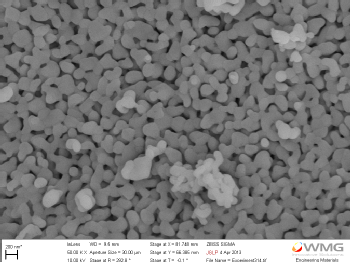Undergraduate Project
This work was completed as part of my undergraduate degree at the University of Warwick; the project comprised 25% of the third year of my Mechanical Engineering degree and was awarded a mark of 96%. Several conference presentations resulted from this work, a list of which can be found at the bottom of this page.
Introduction
Natural bone is a biocomposite material composed of mineral in a collagen matrix. Bone mineral is a calcium phosphate which can be broadly characterised as nonstoichiometric carbonated hydroxyapatite. The mineral contains numerous substitutional ions which increase bioactivity, promoting cellular adhesion and bone growth. For bone tissue engineering, methods are required to produce hydroxyapatite with a similar composition to that of natural bone mineral, and with optimised size, morphology and crystallinity.
The project explored and critically compared the current methods of hydroxyapatite synthesis, then experimentally explored the relatively recent microwave-assisted sythesis method, as well as a novel albumen-mediated synthesis method. Eggshell was used as the calcium source, due not only to the environmental implications of biowaste recycling, but also due to the similarity of substitutional ion content between eggshell and human bone mineral. Detailed analysis was conducted using a variety of techniques, such as Scanning Electron Microscopy (SEM), X-ray Diffractomertry (XRD), Differential Thermal Analysis-Thermogravimetric Analysis (DTA‑TGA) and Fourier Transform Infrared spectroscopy (FTIR), allowing both qualitative and quanititative analysis.
Some additional work was conducted after the project was completed which investigated the use of sonochemistry for the synthesis of hydroxyapatite. This work was then presented at the RSC Materials Chemistry 11 (MC11) conference.
Report Abstract
This report presents an in-depth literature review, along with the results of experiments utilising two separate synthesis methodologies for the production of hydroxyapatite from eggshell-derived precursors. Microwave-assisted synthesis was used, along with a novel albumen-mediated synthesis route developed by the author. The products were characterised using SEM, XRD, DTA-TGA and FTIR.
Microwave-assisted synthesis was shown to produce nanocrystalline hydroxyapatite (HAp) with crystallite sizes less than 20 nm. HAp was synthesised from eggshell-derived Ca(OH)2 and H3PO4, as well as from Ca(OH)2 and (NH4)2HPO4, using pulsed power at 440 W in a domestic microwave, ensuring that the reaction temperature did not exceed 60 °C. Crystallite sizes were seen to be stable for temperatures up to 600 °C with an increase to 30 nm when heated to 800 °C. The thermal stabilities of the produced samples were found to be greatly different, with the HAp produced from the H3PO4 precursor being shown to be stable up to 1169 °C, whilst the HAp produced from (NH4)2HPO4 was found to partially decompose to 29% β-TCP and 71% HAp at 600–800 °C.
The synthesis of HAp was shown to be possible from gelled albumen containing evenly dispersed Ca(OH)2 by burning it in the presence of H3PO4. Mixed morphologies were produced, composed of spheres with diameters less than 2.5 μm and rods with diameters less than 2 μm and lengths less than 6 μm. Thermal stability of the apatite was demonstrated up to 1094 °C, with a biphasic mixture of 88% HAp and 12% Mg-Whitlockite present after sintering at 1200 °C.
HAp nano rods with diameters of 100–300 nm and lengths less than 2 μm were synthesised by the rapid addition of Ca(OH)2 and H3PO4 to freshly extracted egg albumen. A crystallite size of 25 nm was indicated for the as-dried HAp with an increase to 100, 130 and 185 nm corresponding to sintering temperatures of 800, 1000 and 1200 °C, respectively. Thermal stability up to 1000 °C was demonstrated, with a proposed decomposition temperature of 1029 °C; sintering at 1200 °C lead to a conversion to 2.5% Mg-Whitlockite.
Highly amorphous HAp with an estimated crystallite size of 8 nm was synthesised by the rapid addition of (NH4)H2PO4 and eggshell-derived Ca(CH3COO)2 to albumen. The produced HAp was shown to be thermal unstable and decomposed to 90% Mg-Whitlockite and 10% after sintering at 800 °C and further decomposed to 2.5% HAp and 97.5% Mg-Whitlockite upon sintering at 1200 °C. Crystallite size was calculated to be constant at less than 90 nm for sintering temperatures of 800–1200 °C. A near-spherical morphology was produced with typical diameters of 100–250 nm, which were found to have fused into nanoporous structures at a sintering temperature of 800 °C.
Report
For more information, please read my full ![]() Third year project report
Third year project report (11.9 MB)
(11.9 MB)
Conference Presentations
Novel albumen-mediated synthesis of Mg-substituted nano apatites. NR Parsons and KK Mallick (2013), Materials in Medicine 1st International Conference (MiMe) [8th-11th October 2013, Faenza, Italy] ![]() Abstract
Abstract
Sonochemical synthesis and characterisation of hydroxyapatite nanopowders. NR Parsons, KK Mallick and MN Keary (2013), Royal Society of Chemistry 11th International Conference on Materials Chemistry (MC11) [8th-11th July 2013, University of Warwick, UK] ![]() Abstract
Abstract
Rapid synthesis of eggshell derived hydroxyapatite using microwave irradiation. NR Parsons and KK Mallick (2013), UK Society for Biomaterials Annual Conference [24th-25th June 2013, University of Birmingham, UK] ![]() Abstract
Abstract
Rapid synthesis of nanocrystalline hydroxyapatite from biowaste eggshell via microwave irradiation for tissue engineering applications. NR Parsons and KK Mallick (2013), International Conference of Undergraduate Research [10th May 2013, University of Warwick, UK] ![]() Abstract
Abstract
Utilisation of biowaste to bioceramic hydroxyapatite for bone tissue engineering. NR Parsons and KK Mallick (2013), British Conference of Undergraduate Research [15th-16th April 2013, University of Plymouth, UK] ![]() Abstract
Abstract

